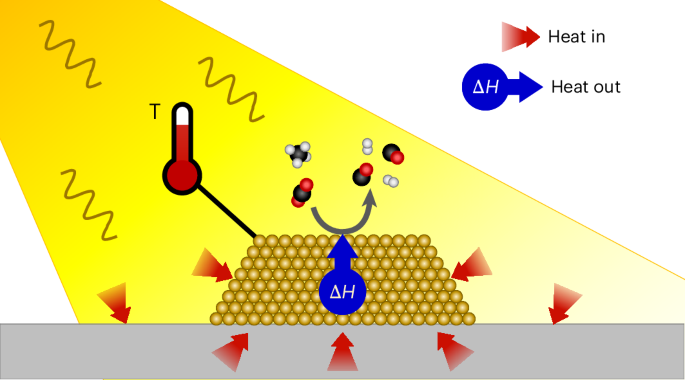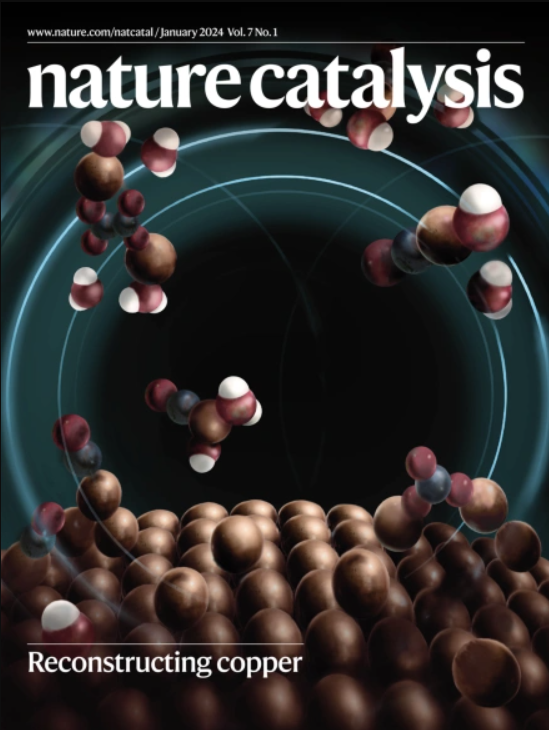Selectively monitoring the operando temperature of active metal nanoparticles during catalytic reactions by X-ray absorption nanothermometry
IF 42.8
1区 化学
Q1 CHEMISTRY, PHYSICAL
引用次数: 0
Abstract
Heat involved in catalytic reactions can influence the local temperature and performance of the active site, potentially causing catalyst degradation and runaway scenarios. Yet, broadly applicable thermometry methods to selectively probe the temperature of the catalytically active phase—where reactions take place—are generally lacking. Here we explore extended X-ray absorption fine-structure thermometry to monitor the operando temperature of active Ni nanoparticles, fully deconvoluted from their metal-oxide support. During dry reforming of methane, the reaction’s endothermicity causes Ni nanoparticles to become local heat sinks with their temperature deviating 90 °C from the reactor temperature. By thermometry at the single nanoparticle level, we chart the energy balance of nanoparticles and relate their temperature to reaction kinetics. Covering the full temperature range relevant to catalysis, this broadly applicable method enables temperature monitoring of individual catalyst components separately. Applying extended X-ray absorption fine-structure thermometry to existing datasets worldwide can generate enhanced understanding on reaction-induced temperature phenomena in heterogeneous catalysis. Monitoring the temperature of a catalyst’s active site during reactions can offer important insights into reactivity, but broadly applicable methods are lacking. Here the authors evaluate the potential of extended X-ray absorption fine-structure thermometry to observe variations in the temperature of nickel nanoparticles throughout representative gas–solid reactions.


用x射线吸收纳米热法选择性地监测催化反应中活性金属纳米颗粒的操作温度
催化反应中的热量会影响局部温度和活性位点的性能,可能导致催化剂降解和失控。然而,广泛适用的温度测量方法来选择性地探测催化活性相的温度-反应发生-通常是缺乏的。在这里,我们探索了扩展的x射线吸收精细结构测温法来监测活性Ni纳米颗粒的操作温度,这些纳米颗粒完全脱离了它们的金属氧化物载体。在甲烷干重整过程中,反应的吸热性导致Ni纳米颗粒成为局部散热器,其温度偏离反应器温度90℃。通过在单个纳米颗粒水平上的测温,我们绘制了纳米颗粒的能量平衡图,并将它们的温度与反应动力学联系起来。覆盖了与催化有关的整个温度范围,这种广泛适用的方法可以单独监测单个催化剂组分的温度。将扩展的x射线吸收精细结构测温法应用于全球现有的数据集,可以增强对多相催化中反应诱导温度现象的理解。
本文章由计算机程序翻译,如有差异,请以英文原文为准。
求助全文
约1分钟内获得全文
求助全文
来源期刊

Nature Catalysis
Chemical Engineering-Bioengineering
CiteScore
52.10
自引率
1.10%
发文量
140
期刊介绍:
Nature Catalysis serves as a platform for researchers across chemistry and related fields, focusing on homogeneous catalysis, heterogeneous catalysis, and biocatalysts, encompassing both fundamental and applied studies. With a particular emphasis on advancing sustainable industries and processes, the journal provides comprehensive coverage of catalysis research, appealing to scientists, engineers, and researchers in academia and industry.
Maintaining the high standards of the Nature brand, Nature Catalysis boasts a dedicated team of professional editors, rigorous peer-review processes, and swift publication times, ensuring editorial independence and quality. The journal publishes work spanning heterogeneous catalysis, homogeneous catalysis, and biocatalysis, covering areas such as catalytic synthesis, mechanisms, characterization, computational studies, nanoparticle catalysis, electrocatalysis, photocatalysis, environmental catalysis, asymmetric catalysis, and various forms of organocatalysis.
 求助内容:
求助内容: 应助结果提醒方式:
应助结果提醒方式:


